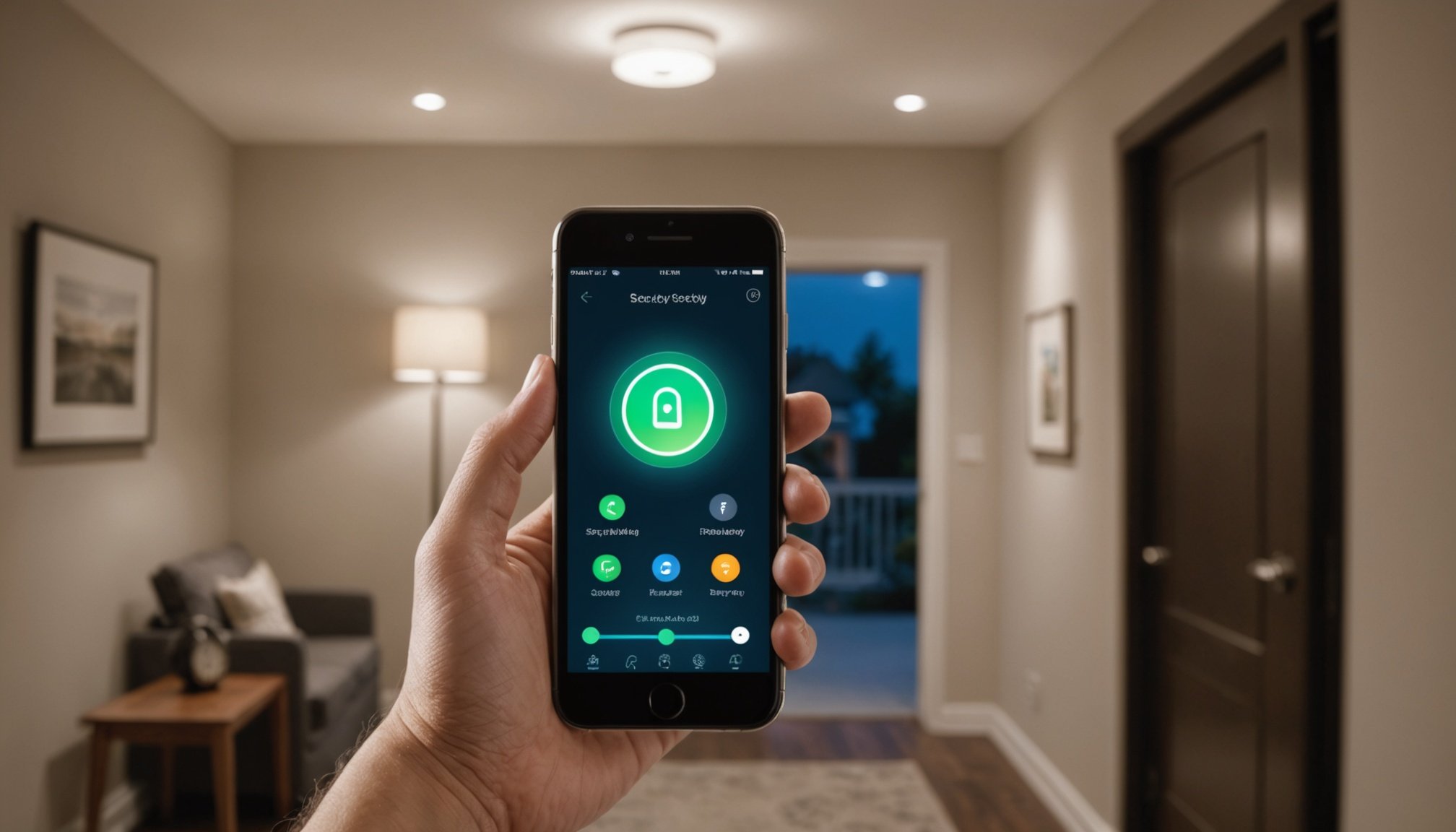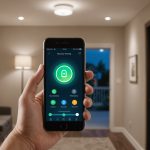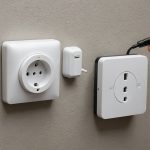Understanding Smart Lighting for Home Security
Smart lighting has emerged as a pivotal technology in enhancing home security. It offers a seamless integration with other security measures, providing homeowners with an efficient way to protect their properties. But how does smart lighting contribute to home security?
Initially, smart lighting acts as a deterrent to potential intruders by simulating occupancy and increasing visibility around property. Automated schedules or motion sensors can trigger lights, making it appear as though someone is home even when the house is empty. This simple yet effective strategy diminishes the risk of break-ins and enhances overall security.
Topic to read : Ultimate diy guide: seamlessly link your smart plug to your smartphone in just a few easy steps!
Smart lighting systems often integrate with home security ecosystems, including cameras and alarms. This creates a unified security network that can be controlled via smartphone apps. Instant notifications about unusual activity allow homeowners to respond quickly, thereby preventing potential threats.
When selecting smart lighting for security purposes, consider these key features:
Also to see : Transform your smart home office: essential tips for streamlined equipment management using your smartphone
- Motion Detection: Activates lights upon detecting movement.
- Remote Access: Control lights from anywhere using a smartphone.
- Customizable Schedules: Vary lighting patterns to mimic presence.
By leveraging these features, smart lighting not only brightens homes but fortifies them against potential intrusions, making it a valuable asset in a comprehensive security strategy.
Selecting the Right Smart Lighting Solutions
Choosing the best smart bulbs involves examining options like colour variety, energy efficiency, and compatibility with existing systems. Some popular choices include Philips Hue and LIFX. While Philips Hue offers extensive integration with smart home ecosystems, LIFX is known for its vibrant colour display without requiring a hub. Make sure your choice suits your existing smart home infrastructure.
Motion sensors enhance convenience by automatically adjusting lighting based on movement. Their integration with smart bulbs maximises energy savings and provides hands-free operation. Motion sensors can be configured to activate bedroom lights when you enter or dim hallway lights at night, promoting safety and energy efficiency.
To illuminate external spaces, well-chosen outdoor lighting solutions are vital. Smart floodlights with motion detection improve security by illuminating driveways, while pathway lights ensure safe navigation and contribute to your home’s evening ambience. Products like Ring’s smart outdoor lights, which pair with security cameras, offer high-tech solutions for added peace of mind.
When planning your smart lighting, consider factors like energy savings, automation, and security to create a cohesive and efficient setup. By evaluating these aspects, you can transform your home into a more efficient, tech-savvy sanctuary.
Configuring Smart Lighting with Smartphone Technology
Smartphone integration offers an effortless way to manage your smart lighting system. Begin by connecting your smart lights to your smartphone with the manufacturer’s companion app. This typically involves scanning a QR code or entering a setup code, linking devices via Wi-Fi or Bluetooth.
Once connected, optimize your experience through the app settings. Enable notifications for software updates to keep your devices secure. Customize light intensity and colour to match your preferences. Adjust geofencing settings to automate lights based on your location, ensuring convenience and energy efficiency.
Automation enhances your lighting experience further. Employ scheduling to turn lights on or off at specific times, or create scenes for different moods with a tap. Use remote controls through your app to manage lights when away from home, boosting security. Additionally, explore routine commands that allow lights to respond to triggers such as sunrise or sunset.
Through thoughtful app settings and automation strategies, your smartphone becomes the control centre for a smart, adaptable lighting setup. This not only improves convenience but also enhances energy efficiency and home security.
Automation and Synchronization for Security Measures
Incorporating automation and synchronization into your home security can greatly enhance protection. Take smart lighting for example. Automating these lights can create an illusion of occupancy even when the house is vacant. This can be achieved by setting lights to turn on and off at random intervals, simulating your presence.
Synchronizing lighting with security features such as cameras and alarms adds a layer of sophistication. An effective setup could involve synchronizing exterior lights to activate upon detecting movement from security cameras. This sudden illumination can deter potential intruders. Additionally, integrating alarms into this system ensures that you’re alerted in real-time.
For those keen on bolstering their home’s security, devise realistic lighting patterns. Simple techniques, like setting bedroom lights to dim at a specific time, can replicate normal evening routines. By carefully planning lighting routines, you can ward off unwanted attention.
Here are some tips:
- Synchronize your systems to work seamlessly.
- Use motion-detection technology to trigger external lights.
- Test routines to refine how believable they appear.
Such automation empowers homeowners to feel secure and vigilant, providing a reliable safeguard against intrusions.
Effective Setup Examples for Enhanced Security
Smart home setups are transforming how we protect our spaces. Case studies of successful smart lighting installations provide insight into enhancing security effectively. By examining these examples, homeowners can learn how best to configure their own systems.
Consider a house situated in a suburban area where a comprehensive smart lighting solution was installed. This involved integrating motion sensors with outdoor smart lights. Whenever movement was detected, the lights would not only illuminate but also trigger security cameras, ensuring full coverage. This system greatly reduced false alarms and boosted neighbourhood security.
Visual aids can be particularly helpful in selecting the optimal smart home setups. Diagrams showcasing strategic placement of smart lights—such as at entrances, pathways, and blind spots—highlight the potential for deterring potential intruders. A properly illuminated property is less likely to be targeted.
From these effective installations, a few key takeaways stand out:
- Motion sensor integration enhances responsiveness.
- Strategically placed lights provide optimal coverage.
- Incorporating security cameras with lighting ensures visual records.
By adopting insights from such case studies, homeowners can achieve heightened security that is both proactive and efficient in deterring crime.
Integrating Smart Lighting with Existing Security Systems
Integrating smart lighting with your existing home security systems can significantly enhance your security setup. Smart lighting acts as a deterrent by simulating presence through automated lighting schedules. It brightens shadowy areas when motion is detected, further increasing security.
Compatibility Considerations
When planning to incorporate smart lighting, assess compatibility with your current security systems. Many smart lights are designed to connect with popular smart home ecosystems, offering seamless integration without complex modifications. Ensure the smart lighting firmware is up-to-date, as manufacturers frequently release updates to improve compatibility.
Strategic Integration Tips
To maximize security effectiveness, consider these tips:
- Positioning: Install smart lighting in vulnerable areas, such as entry points or pathways.
- Automation: Leverage automation features like geofencing or scheduling to mimic occupancy.
- Integration: Sync with motion sensors to trigger lights when movement is detected.
By thoughtfully integrating smart lighting, homeowners can create a more intimidating environment for intruders while enjoying the convenience of automated home controls.
Potential Security Benefits of Smart Lighting
Smart lighting technology offers several security benefits that extend beyond the mere illumination of spaces. One significant advantage is its role in crime prevention. Studies have shown that well-lit environments can significantly reduce criminal activities, as visibility often deters potential wrongdoers. When integrated with smart home systems, these lights can be programmed or automated to simulate occupancy, providing an additional deterrent effect against intruders.
On a psychological level, the presence of lighting impacts the behaviour of potential intruders. Illuminated areas can create a perception of exposure and increase the risk of being noticed, thus making criminals think twice before approaching. The unpredictability of smart lighting, such as lights turning on at random intervals, further enhances this deterrence.
Incorporating smart lighting technology offers long-term advantages for homeowners. Beyond immediate security improvements, it can contribute to peace of mind, knowing that the home environment is safer. Additionally, smart lighting is energy-efficient, reducing electricity costs over time. These features combined make smart lighting a valuable and practical investment for enhancing home security and overall property safety.











